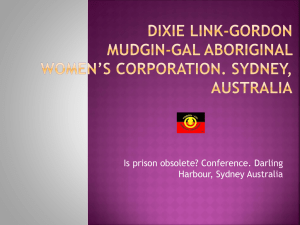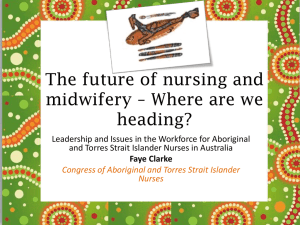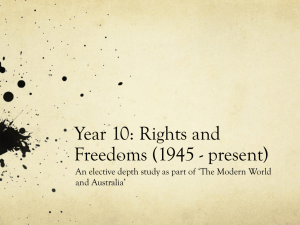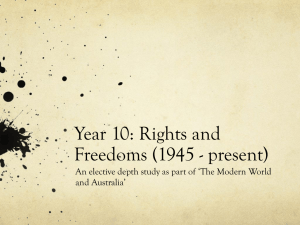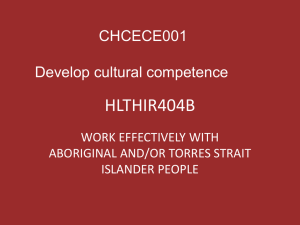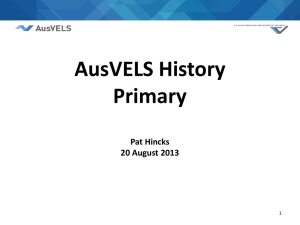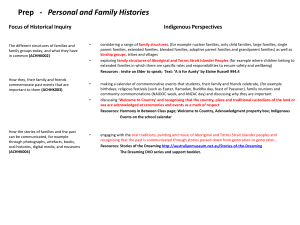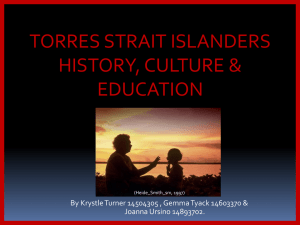View the presentation slides here
advertisement
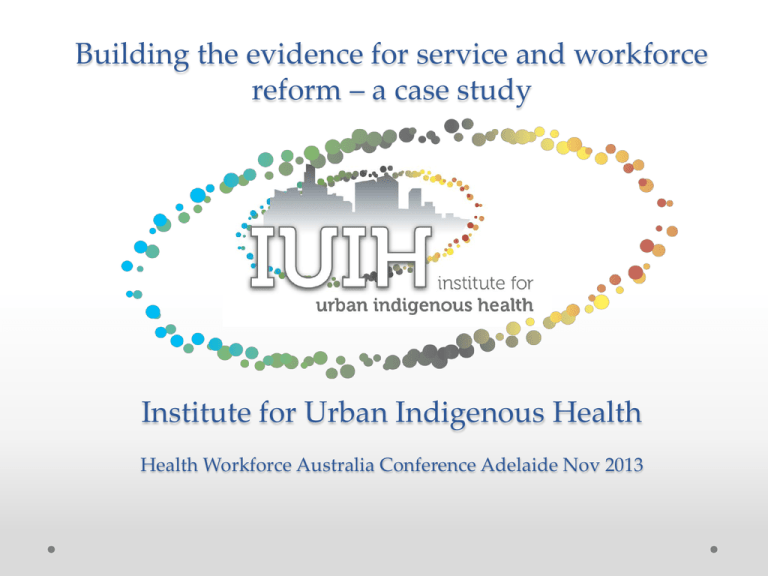
Building the evidence for service and workforce reform – a case study Institute for Urban Indigenous Health Health Workforce Australia Conference Adelaide Nov 2013 Life expectancy at birth in selected countries Source: Population Division of DESA UN Secretariat: World Population Prospects: the 2008 Revision Population Database www.un.org Causes of excess mortality * External causes include intentional self-harm, accidents, assaults, poisoning Burden of disease – Disability Adjusted Life Years (DALYs) Vos T, Barker B, Stanley L, Lopez AD 2007. The burden of disease and injury in Aboriginal and Torres Strait Islander peoples 2003. Brisbane: School of Population Health, The University of Queensland. % Indigenous Health Gap (DALYs) by selected causes – by remoteness Vos T, Barker B, Stanley L, Lopez AD 2007. The burden of disease and injury in Aboriginal and Torres Strait Islander peoples 2003. Brisbane: School of Population Health, The University of Queensland. Maternal and neonatal outcomes for an urban Indigenous population compared with their non-Indigenous counterparts Sue Kildea, Helen Stapleton, Rebecca Murphy, Machellee Kosiak and Kristen Gibbons. BMC Pregnancy and Childbirth 2013, 13:167 doi:10.1186/1471-2393-13-167 Projected Indigenous population 2006 - 2031 Nicholas Biddle: CAEPR Indigenous Population Project 2011 Census Papers No. 14/2013 – Population Projections. http//caepr.anu.edu.au/publications/censuspapers.php Nicholas Biddle: CAEPR Indigenous Population Project 2011 Census Papers No. 14/2013 – Population Projections. http//caepr.anu.edu.au/publications/censuspapers.php No. of completed health assessments 2008-09 General Practice Network No of 708 checks % of eligible children screened No of 710 checks % of eligible adults screened South East Alliance 59 3.4 126 4.5 Brisbane South 195 12.3 452 17.3 Gold Coast 35 1.5 28 2 Logan Network 42 1.1 67 2.2 Ipswich 74 2 52 2 Moreton Bay 0 0 14 0.6 GP Partners 27 3 35 0.8 Total 432 3 774 4.1 What was the evidence in SEQ? • Limited reliable evidence available on the specific needs of urban Aboriginal and Torres Strait Islander people in SEQ • Approximately 20-25% of the Aboriginal and Torres Strait Islander population were accessing ATSICCHS clinics; limited evidence available suggested mainstream was not well equipped to be able to respond • Focus of Indigenous specific COAG investment by Government on remote communities; focus in urban and regional areas centred on enhancing access to mainstream services • Continued growth and dispersal of Indigenous population with ‘shift’ to outer-urban areas – concentration of populations in areas of low socioeconomic areas, distant from where ATSICCCHS clinics were originally located • Competing interests - including efforts to secure new resources – amongst ATSICCHS located within the SEQ region • Uncertainty regarding continued grant funding, with mounting imperative to reduce reliance on grant funding and to increase long-term economic viability of ATSICCHS • Complexities of coordinating care across range of different health and related service providers Our Vision The vision of the IUIH is to achieve equitable health outcomes for urban Aboriginal and Torres Strait Islander peoples and to ensure that all Aboriginal and Torres Strait Islander people in the south east Queensland region have access to culturally safe and comprehensive primary health care. Institute for Urban Indigenous Health • Established as public company limited by guarantee • Mixed-Board structure, with: • 1 representative from each member ACCHS: • ATSICHS Brisbane • Kambu Medical Centre • Yulu-Burri-Ba Health Service • Kalwun Health Service PLUS • 4 directors appointed for specific skills: • Social Marketing/Community Engagement • Research /Teaching • Finance/Business/Governance • Clinical/Public Health The IUIH aims to increase health service access and opportunities through provision of support for Aboriginal and Torres Strait Islander health service development and coordination across the SEQ region. The IUIH also aims to support the effective implementation of the COAG ‘Close the Gap’ initiatives and other strategic developments in the region with emphasis on promoting partnerships and integration with other mainstream health services. Responding to the evidence – system and service reform • Identify and prioritise areas of SEQ for new ATSICCHS clinics establishment • Coordinate a strategic regional approach to community engagement, health promotion and service access • Redesign health service systems to improve efficiency and quality, and to increase generation of MBS income • On behalf of member ATSICCHS, forge partnerships with mainstream agencies and providers to enhance the response to the needs of Aboriginal and Torres Strait Islander people in SEQ • Develop a coordinated regional response to the development of a sustainable Indigenous health workforce From evidence to system reform… • Identify and prioritise areas of SEQ for new ATSICCHS clinics development • Coordinate a strategic regional approach to community engagement, health promotion and service access • Redesign health service systems to improve efficiency and quality, and to increase generation of MBS income • On behalf of member ATSICCHS, forge partnerships with mainstream agencies and providers to enhance the response to the needs of Aboriginal and Torres Strait Islander people in SEQ • Develop a coordinated regional response to the development of a sustainable Indigenous health workforce Suburbs in catchment Indigenous population Active AMS Clients Target % of population = population 50% catchment New clients needed to reach target* 1603 807 371 589 2536 229 147 226 324 1211 14% 18% 61% 55% 48% 802 404 186 295 1674 573 257 0 0 463 728 79 11% 364 285 25 57 70 322 67 2 1 9 25 11 8% 2% 13% 8% 16% 13 29 35 161 34 11 28 26 136 23 47 2 4% 24 22 Indigenous Population by Suburb/Division of General Practice 0 to 10 10 to 25 25 to 50 50 to 100 100 to 200 200 to 500 500 to 3,500 From evidence to system reform… • Identify and prioritise areas of SEQ for new ATSICCHS clinics development • Coordinate a strategic regional approach to community engagement, health promotion and service access • Redesign health service systems to improve efficiency and quality, and to increase generation of MBS income • On behalf of member ATSICCHS, forge partnerships with mainstream agencies and providers to enhance the response to the needs of Aboriginal and Torres Strait Islander people in SEQ • Develop a coordinated regional response to the development of a sustainable Indigenous health workforce Community engagement, health promotion & service access • • • • • Deadly Choices program Marketing Community Days Incentives – Deadly Choices shirts, competitions, etc. Targeted, localised engagement strategy linking back to clinics – Community Liaison Officers From evidence to system reform… • Identify and prioritise areas of SEQ for new ATSICCHS clinics development • Coordinate a strategic regional approach to community engagement, health promotion and service access • Redesign health service systems to improve efficiency and quality, and to increase generation of MBS income • On behalf of member ATSICCHS, forge partnerships with mainstream agencies and providers to enhance the response to the needs of Aboriginal and Torres Strait Islander people in SEQ • Develop a coordinated regional response to the development of a sustainable Indigenous health workforce The organised approach… we need the organised approach - not the ‘organ’ approach” From evidence to system reform… • Identify and prioritise areas of SEQ for new ATSICCHS clinics development • Coordinate a strategic regional approach to community engagement, health promotion and service access • Redesign health service systems to improve efficiency and quality, and to increase generation of MBS income • On behalf of member ATSICCHS, forge partnerships with mainstream agencies and providers to enhance the response to the needs of Aboriginal and Torres Strait Islander people in SEQ • Develop a coordinated regional response to the development of a sustainable Indigenous health workforce From evidence to system reform… • Identify and prioritise areas of SEQ for new ATSICCHS clinics development • Coordinate a strategic regional approach to community engagement, health promotion and service access • Redesign health service systems to improve efficiency and quality, and to increase generation of MBS income • On behalf of member ATSICCHS, forge partnerships with mainstream agencies and providers to enhance the response to the needs of Aboriginal and Torres Strait Islander people in SEQ • Develop a coordinated regional response to the development of a sustainable Indigenous health workforce Develop a coordinated regional response to the development of a sustainable Indigenous health workforce 1. What workforce do we need to meet demand in SEQ? • What type / composition? • How much? 2. How do we develop the skills and capacity of the existing workforce to do the job? 3. How do we successfully expand the workforce to keep up with future growth and demand? 4. How do we specifically enhance Aboriginal and Torres Strait Islander employment and career development? Develop a coordinated regional response to the development of a sustainable Indigenous health workforce 1. What workforce do we need to meet demand in SEQ? • What type / composition? • How much? 2. How do we develop the skills and capacity of the existing workforce to do the job? 3. How do we successfully expand the workforce to keep up with future growth and demand? 4. How do we specifically enhance Aboriginal and Torres Strait Islander employment and career development? If the full “cycle of care” is completed for everyone who’s eligible, what does a daily workload look like? Assumptions and calculations: • 1 GP per 1000 regular Aboriginal and Torres Strait Islander clients… • a full cycle of care is completed for all regular clients of the service over a 12 month period • At least 30% of total regular client population will be eligible and benefit from a GPMP /TCA (this is conservative) • 50% of nurse follow up visits after 715 and 100% nurse follow up visits after GPMP/TCA are captured in a 12 month cycle • 2 AHW allied health items after a 715 and 1 of these items after a GPMP /TCA is claimed in a 12 month cycle • Remaining GP time in the day is taken up with mostly mid-range consultations – around 20 mins duration Year Day $/item Total $/day GP Contacts 715 (100%) 800 3 $ 204.20 $ 612.60 GPMP (30%) 240 1 $ 138.75 $ 138.75 TCA (30%) 240 1 $ 109.95 $ 109.95 GPMP / TCA RV (3/y) 720 3 $ 138.70 $ 416.10 4 $ 35.60 $ 142.40 12 $ 69.00 $ 828.00 1 $ 101.50 $ 101.50 Other consultations short medium long Non-GP contacts RN 715 800 3 RN GPMP/TCA 240 1 RN F/U 715 (10987) 4000 16 $ 23.55 $ 376.80 RN F/U GPMP/TCA (10997) 1200 5 $ 11.80 $ 59.00 AHW F/U 715 (81300) AHW F/U GPMP/TCA (10950) 1600 6 $ 51.95 $ 311.70 240 1 $ 51.95 $ 51.95 $ $ 82.60 10990 (50% cons) 14 5.90 1x GP 1x Practice Manager 1 x Community Liaison Officer 1 x Driver 1.5 - 2 x Receptionists 1 x Aboriginal Health Worker 1 x Clinic Nurse 1 x Chronic Disease Nurse Key principles 1. Everyone is critical, no-one is spare and everyone will be missed if they’re absent – so also need multi-skilled workforce 2. Everyone is used to their license 3. Health professionals other than GPs not only to support effective engagement, access and care, but also make a significant (around 25%) contribution to generation of MBS revenue through interactions NOT involving contact with GP 4. Size matters – in this model, begin to lose efficiency once service grows beyond a 2 GP core Develop a coordinated regional response to the development of a sustainable Indigenous health workforce 1. What workforce do we need to meet demand in SEQ? • What type / composition? • How much? 2. How do we develop the skills and capacity of the existing workforce to do the job? 3. How do we successfully expand the workforce to keep up with future growth and demand? 4. How do we specifically enhance Aboriginal and Torres Strait Islander employment and career development? 1. Mapped functions to job roles development of standardised regional position descriptions, avoiding duplication and ensuring all key functions are covered 2. Focus on skills not qualifications 3. Training needs – individual assessment and development of training plan 4. Partnership with training institutions to secure access to industry-specific training for SEQ ATSICCHS workforce 5. On-the-job training – emphasis on skills transfer (formalised in PDs), mentorship and supervision, interdisciplinary learning 6. Developing Proper Partnerships – cultural mentor program Develop a coordinated regional response to the development of a sustainable Indigenous health workforce 1. What workforce do we need to meet demand in SEQ? • What type / composition? • How much? 2. How do we develop the skills and capacity of the existing workforce to do the job? 3. How do we successfully expand the workforce to keep up with future growth and demand? 4. How do we specifically enhance Aboriginal and Torres Strait Islander employment and career development? A home grown workforce • Funding and support from GPET / RTPs to support postgraduate medical training – 0.5 medical educator expanded GPR placements from 1 historically to 7 in 2013 • Funding from UQ for a full-time position to support effective undergraduate student placements Regional capacity to enhance both volume and quality of training experience for both trainees and services Semester 1 2013 Medicine Occupational Therapy Dentistry and Oral health Speech Pathology Human Movement Studies Optometry Psychology Nursing and Midwifery Pharmacy Podiatry Political Science Business and Economics Social Work Counselling Arts Biomedical Science Discipline Type of Placement Project Pharmacy 4 weeks F/T starting 22/7 Developing links with local pharmacies – improving pharmacy education for Work It Out sessions Pharmacy Health Science 4 weeks F/T starting 22/7 One day/week for 11 weeks starting 22/7 Health Science One day/week for 11 weeks starting 22/7 Health Science 4 days/ week for 10 weeks starting 22/7 Work it Out – assisting with organising, administering, collecting and analysing data from pre and post assessments for Work it Out Clients (could include one day/week at Murri school sorting follow up from health check days) Occupational Therapy 1 day/week for 11 weeks starting 29/7 Embedding parent activities alongside Tumbletime, tools for school, Tumble-tots programs to further engage parents and to model strategies that can be used at home to expand and extend the children’s learning and skill development. Occupational Therapy and Speech Therapy 1 day/week for 11 weeks starting 29/7 Developing a group literacy program with SLP students Occupational Therapy 1 day/week for 11 weeks starting 29/7 Development of an innovation showcase for SE Qld CCHS’s Political Science One day/week for 11 weeks starting 22/7 Developing a legal and ethical framework for shared electronic health records in South-East Qld CCHS’s Political Science One day/week for 11 weeks starting 22/7 Warriors: Developing and implementing an evaluation framework and followup plan for participants of the Warriors program Psychology 3 days/week starting 22/7 Audit of Webster pack ordering – process and protocol - Kambu B.u.bs Club – developing a teddy-bears picnic and calendar of developmental milestones Tobacco cessation program evaluation Parenting programs evaluation and development of a framework Develop a coordinated regional response to the development of a sustainable Indigenous health workforce 1. What workforce do we need to meet demand in SEQ? • What type / composition? • How much? 2. How do we develop the skills and capacity of the existing workforce to do the job? 3. How do we successfully expand the workforce to keep up with future growth and demand? 4. How do we specifically enhance Aboriginal and Torres Strait Islander employment and career development? Supporting Aboriginal and Torres Strait Islander training, employment and career development • ‘Pipeline” beginning with schools-based traineeships – e.g. in 2013, cert II and Cert III allied health assistant training • Cadetships; scholarships – service-funded as well as coordination of funding from other sources • Indigenous Youth Sports Program (IYSP) • Mentor program – 2 way learning • Critical mass In addition to Aboriginal and Torres Strait Islander managers, ATSIHWs and nurses, now also exercise physiologist, speech therapist, oral health therapist, dental assistants, researchers including 2 PhD students, etc. Managing system reform and improvement Strong leadership Simultaneous governance reform Role of the IUIH “Spearhead” Clinical governance framework Continuous quality improvement: • Research and evaluation • Closing the data loop – monthly CQI meetings, regional Lead Clinician Group meetings • Motivating change – Team Incentive Plan; Leagues Table Health Assessments GPMPs Health Assessments - % of TIP targets reached by clinic 180% 160% 140% 120% 100% 80% 60% 40% 20% 0% 1 2 3 4 5 6 7 8 9 10 11 12 DIABETES DM care plan 99 No DM care plan PLUS BSL > 11 or HbA1C >6.6% 34 RESPIRATORY DISEASE Asthma or chronic respiratory care plan No asthma or CR care plan PLUS on bronchodilator or preventive puffer medication 74 67 CARDIOVASCULAR DISEASE Coronary artery disease care plan No CAD care plan PLUS on antianginal, b-blocker or anti-coag medication 13 36 KIDNEY DISEASE Any CKD or ESKD care plan 10 No CKD care plan PLUS eGFR <60 or creatinine <120 17 Proteinuria Care Plan 13 No proteinuria care plan PLUS ACR > 10 22 Collaboration and coordination – a case example Signing of statement of intent – IUIH / Brisbane ATSICHS / MNBML / Metro north HHS 3 new clinics in the last 2 years in Moreton Bay region (8500 population) – already reaching around 3500 clients Workforce – over 80% all staff are Aboriginal and Torres Strait Islander; 2 GPRs; 2 Aboriginal RN trainees; 2 AHW trainees On target with Team Incentive Plan; early measures of clinical performance promising; cost-benefit analysis underway (IUIH-contracted health economist) Subcontracted by MNBML to run CTG program; contracted by MNHHS to deliver Care Connect Oral Health Service: • Fixed chair in Deception Bay clinic funded as part of capital establishment (QH) • Mobile Van funded by DOHA • Dentist and dental assistant – start up funding through Medicare Local (MNBML) • Funding from QH for Oral Health Therapist (new Aboriginal graduate with initial supervision from QH OHT undertaking research project) • Ongoing operation – Medicare revenue generated through PHC service; vouchers from QH for clients on wait list >5 years, Teen Dental funding % Aboriginal and Torres Strait Islander clients up to date with health assessment (715) Male 65% 71% Female Active 16-29 year old Aboriginal and Torres Strait Islander clients with chlamydia screen in the last 12m 100% 90% 80% 70% 60% 50% 40% 30% 20% 10% 0% Male Female Cohort of clients with diabetes: % change in selected measures from year 1 to year 2 (n=35) 60% 50% 40% 30% 20% 10% 0% Smoking status assessed ACR last 12m BMI obese BMI overweight BMI normal BMI last 6m Last TC <4 TC last 12m HbA1C >10% HbA1C <7.5% HbA1C last 6m Last BP diastolic <80 -30% Last BP systolic <130 -20% BP last 6m -10%

